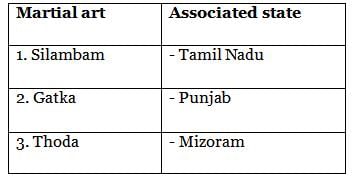Manipur PSC Prelims Paper 1 Mock Test - 5 - Manipur CSCCE MCQ
30 Questions MCQ Test - Manipur PSC Prelims Paper 1 Mock Test - 5
With respect to the history of the Ancient India, the terms such as ‘Ramapithecus’ and‘Sivapithecus’ were used to represent:
Which reference to social conditions duringthe Gupta period, which one of the followingstatements is correct?
Consider the following statements with respect to the teachings of Jainism:
1. Right faith is the belief in the teachings and wisdom of Mahavira.
2. Right knowledge is the acceptance of the theory that the world has been created by God.
3. Right conduct refers to the observance of the five great vows.
Which of the statements given above is/are correct?
Consider the following pairs :

Which of the pairs given above is/are correctly matched?
With reference to the various approaches to Human Development, consider the following statements:
The Welfare approach to human development advocates that the level of income reflects the level of freedom enjoyed by an individual.
The Basic needs approach ignores the aspect of human choices in human development.
Capability approach is based on building human capabilities in the areas of health, education and access to resources.
Which of the statements given above is/are correct?
Which of the following statement are correct about the Earth's crust ?
1. The most abundant rocks in the crust are igneous rocks.
2. The Oceanic crust is less dense than the Continental crust.
3. The continental crust can be as thick as 70 km, whereas the oceanic crust can extend up to 10 km.
Select the correct answer using the codes given below :
Which of the following are cold ocean currents?
1. Labrador Current
2. Kuro siwo
3. Benguela Current
4. Falkland Current
5. Norwegian Current
Choose the correct answer from the codes given below :
Consider the following statements:
The independence of judiciary means that
The judges must be able to perform their functions without fear or favour.
The organs of the government should not interfere with the decision of the judiciary.
The judiciary should be free from any kind of accountability.
Which of the statements given above is/are correct?
The 'Objective Resolution' was unanimously adopted by the Constituent Assembly on 22nd January 1947. Consider the following provisions of the Resolution:
1. Adequate safeguards shall be provided for minorities, backward and tribal areas, and depressed and other backward classes.
2. All power and authority of Sovereign Independent India, its constituent parts and organs of government, are derived from the head of states.
Which of the statements given above is/are correct?
If the Reserve Bank of India (RBI) increases the bank rate, what effects it could possibly have on the Indian economy?
1. Loan taken by the commercial banks becomes cheaper.
2. It decreases the money supply in the economy.
Select the correct answer using the code given below.
Consider the following statements with respect to poverty in India :
1. The headcount ratio is the percentage of the population living below the poverty line
2. The official data on poverty is estimated on the basis of data collected by NITI Aayog.
Which of the statements given above is/are correct ?
Funds availed under Kisan Credit Card (KCC) scheme can be used by farmers for which of the following purposes?
- Post-harvest expenses
- Consumption requirements of farmers household
- Short-term credit requirements for cultivation of crops
- Working capital for maintenance of farm assets and activities allied to agriculture, like dairy animals, inland fishery etc.
- Produce Marketing Loan
- Investment credit requirement for agriculture and allied activities like pump sets, sprayers, dairy animals etc.
How many of the statement(s) given above is/ are correct?
Consider the following statements regarding Photosynthetically Active Radiation (PAR):
1. It constitutes more than 50 percent of incident solar radiation.
2. Plants capture less than 10 percent of the PAR energy that sustains the entire world.
Which of the statements given above is/are correct?
Consider the following statements regarding a voltmeter:
- It is always connected in series across the points between which the potential difference is to be measured.
- A voltmeter has a very high internal resistance.
Which of the statements given above is/are correct?
Which of the following elements is/are rare earth elements?
- Neodymium
- Promethium
- Hohnium
Select the correct answer using the code given below.
With reference to ‘Polygraph tests’ consider the following statements
- Polygraph tests, commonly known as lie detector tests, are admissible as evidence in Indian courts.
- The use of polygraph tests in India is regulated by the Narcotic Drugs and Psychotropic Substances Act
- Consent from the individual undergoing the polygraph test is not required for it to be legally administered in India
How many statement(s) given above are correct
Who was the contemporary of Buddha and patronized Buddhism?
Consider the following statements:
- The last ruler of the Satavahana dynasty was Pulamavi IV, after whom the empire disintegrated into smaller states.
- The Satavahana dynasty had strong trade links with Southeast Asia.
- The primary coinage material during the Satavahana period was gold.
How many of the statements given above are correct?
Which ruler defeated Harsha and brought an end to the Vardhana Dynasty?
Which Mughal emperor revived the Indian tradition of painting and introduced new themes, colors, and forms?
Which mode of interaction helped in the spread of Indian culture abroad?
What proportion of agricultural produce was levied as land tax during King Harshavardhana's reign?
Which religious inclination did King Harshavardhana embrace later in his life under the influence of the Chinese traveler Hieun Tsang?
Which seismic waves can travel through both solids and liquids?



















